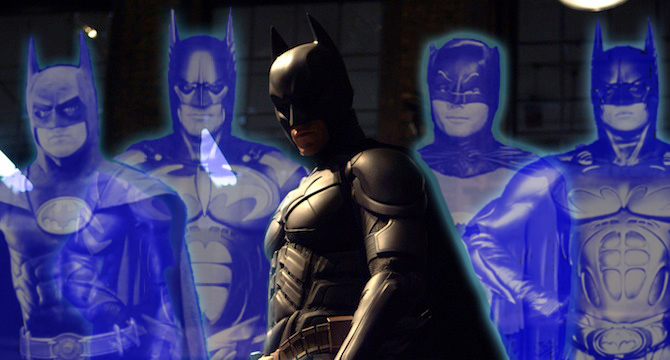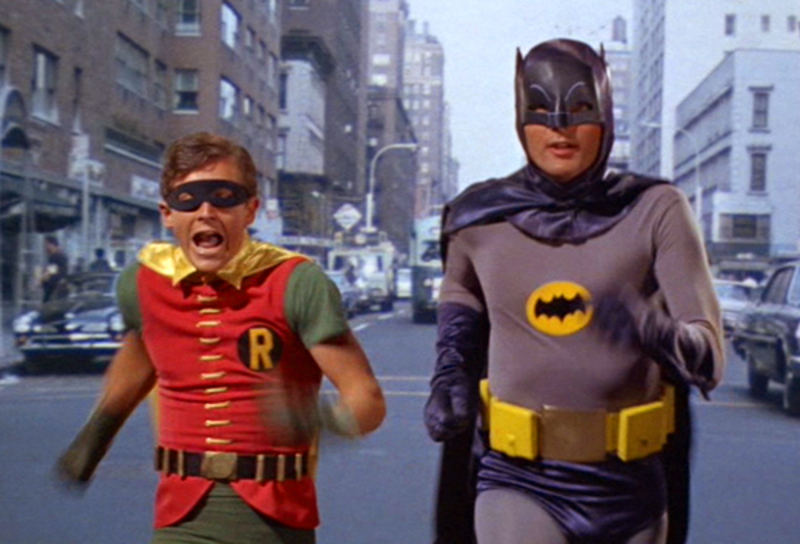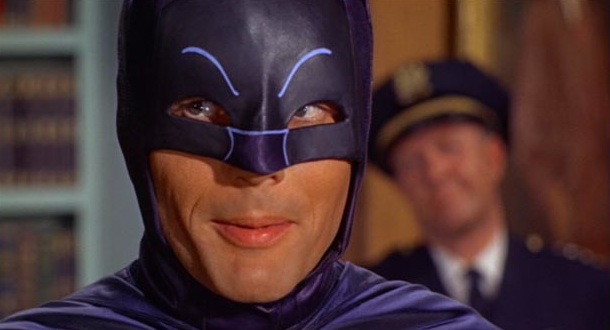Loving 1960s Batman TV show sometimes seems like counter-intuitive nostalgia. We tend to praise it as camp, or kitsch, while buying into the assumption that it somehow got Batman “wrong” by portraying the character and themes in terms of comedy, rather than the brooding drama it’s “supposed” to be. But with the long-awaited release of the entire series on DVD/Blu-ray this week, it’s time to recognize that Batman and its intentionally zany zap-pow tone is so much smarter than you remember. And even if you don’t think of Adam West’s most famous character as “real Batman,” I’d argue that West’s Batman set the bar for the way all of us think about any and every on-screen version of The Dark Knight since…
Larger-than-life pop narratives starring over-the-top heroes are like rollercoasters. And I’m not referring to the straightforward up-and-down nature of any fictional adventure story, but instead, the hulking, twisting rollercoaster of our fickle culture, with its shifting attitudes and sensibilities. When it comes to comic book adaptations for the big or small screen, fans, critics, and casual viewers are always using various—and often opposing—criteria in order to figure out how and why they do or don’t like a certain comic book adaptation.
In the 60s, though, I’d argue most comic book fans weren’t loaded down with all those disparate criteria. This may seem like an oversimplification, but my guess is that if we were to time-travel back to the living rooms of a big DC comics aficionado when the 60s Batman came on TV, they wouldn’t be shaking their heads-with-oh-no-Batman-canon-is-being-ruined disgust, but instead, taking what they could get. Look! It’s Batman! And holy-gosh, he’s on TV!
Whether Burt Ward’s Robin was manically spinning absurd hyperbole (“Holy contributing to the delinquency of minors!”) or Adam West’s Batman was delivering weird understatements with dry wit (“Some days you just can’t get rid of a bomb!”) the purpose of this version of Batman was fundamentally to entertain its audience with an unprecedented mix of broad humor and wry sarcasm. Caesar Romero’s Joker has a visible mustache under this white clown make-up; Frank Gorshin is practically slapping himself in the face he’s so nuts as the Riddler; Eartha Kitt plays Catwoman with an arch ferociousness that can seem almost psychotic at times, but still drives a crazy “Kitty Car” with a furry tail sticking up in the back. (Julie Newmar and Lee Meriwether are good as Catwoman in the 60s, duh, but Kitt is the fiercest.)
Everyone is kidding around in the 60s Batman, but no one is breaking character, and no one is laughing at their own jokes. The earnestness of Adam West’s Batman is equal to Christian Bale’s, only the former isn’t using a funny voice and the latter, obviously, is (albeit unintentionally). What is “supposed” to be funny comes across serious to a little kid (West) and what is “supposed” to be serious comes across funny to an adult (Bale’s accidentally silly Bat-growl). The Pixar movies figured out this paradox a long time ago.
But, after a decade or two, “real” comic book fans didn’t want a funny Batman, because that’s not “really” Batman. Which is fair, and, in terms of tone of over-half the comics, totally true. So what’s happened since then? Quite a bit, but here’s where I think we’ve ended up, at least in relation to Batman adaptations, specifically:
The current thinking among comic book folks is that the 1960s Batman is cute, but not “real” Batman. The Tim Burton films are OK because they are “darker,” but are too surreal and alter (or invent) too much of the established mythology to be taken seriously. Meanwhile, the Schumacher films are embarrassing toy and/or Taco Bell commercials, while the late 90s Batman: The Animated Series is the real deal. This means Christopher Nolan’s “Dark Knight” trilogy easily wins all of Batman adaptations to date, as it specifically references numerous comic book storylines, and seems to strike the correct tone of psychological realism-meet-super-heroic melodrama that loosely equates with how many fans define the essence of “real Batman.”
Let’s get real here: the above paragraph pretty much sums up the general feeling most people have about Batman adaptations. I’m not trying to judge quality or correctness of which adaptations are or are not “real” Batman. I’m just trying to invent a scale by which all Bat-daptions are judged, and it has nothing to do with comic-book source material. This is the first and best law of understanding Bat-daptions. Here it is:
After the 1960s, all major Batman adaptations represent either a movement in popular opinion toward Adam West-Batman or a movement away from Adam West-Batman.
Search your bat-feelings: you know it to be true. Burton’s 1989 Batman represents the first time since the 1960s that Batman loomed large on the non-comic book world stage. The character’s appearances in Scooby-Doo, The New Adventures of Batman and Super Friends hardly counts, and even if they do, those versions of Batman owed quite a debt to Adam West’s characterization.

Both Michael Keaton Batman movies, though—Batman and Batman Returns—center on a character that is unrecognizable as Batman if you only knew about the character from the TV series. Saying Burton was moving toward the original, darker Batman of the comics may be superficially true, but there are so many devils in the details (dancing in the pale moonlight) that I’d argue that wasn’t Burton’s motivation at all. Instead, what he’s really doing is moving away from Adam West’s over-the-top zaniness. Burton didn’t care about the comics: he cared about Keaton NOT being Adam West.
In that sense, one could argue that Batman Forever and Batman and Robin are overt and obvious movements back toward Adam West. In fact, Batman and Robin in almost every way, can be read as a sloppy attempt to actually pay homage to the kitsch of the 60s show, without any of the innocence, charm, or sadly, wit. Running almost simultaneously to Batman Forever and Batman and Robin you’ve got Batman: The Animated Series on TV, which is a defacto movement away from Adam West as it adopts the general tone of the Burton films (often literally, in terms of the Danny Elfman/Shirley Walker score). BUT, as The Animated Series becomes The Adventures of Batman and Robin, it loses some of its edge, and heads towards a more light-hearted feeling, meaning that it circles back toward Adam West territory.
Now, this isn’t to say you can’t have adaptations from the same time period which are moving different directions on the Adam West scale (Batman: The Animated Series AWAY, Batman Forever TOWARDS)—just that it’s important to understand that the Adam West scale exists. So, Ben Affleck’s impending Batman might not necessarily be lighter than Christian Bale’s, but I’d argue popular opinion is swinging more towards wanting a fun Batman than a sad, gritty Batman. Meaning that Affleck will, even unconsciously, be channeling Adam West, because the zeitgeist bat-o-rang is probably swinging irrevocably back in that direction.
60s Batman showrunner William Dozier cultivated an atmosphere of overtly liberal and over-the-top-good-guy-earnestness that ultimately defines the show, which is the ultimate key to why it works so well: it plays with contrasts perfectly. Batman is willing to break the law in a conventional sense (jumping through windows into buildings he doesn’t live in) but he’ll never have a drink while he’s “working.” (In fact, he doesn’t drink at all.) When the Joker randomly gets hold of a machine that can SPEED UP AND SLOW DOWN TIME, he uses it only to rob banks in the most comical way possible. When Batman runs for mayor against the Penguin (brilliant, brilliant Burgess Meredith), he REFUSES to kiss a baby, because, you know, germs. Adam West’s Batman isn’t a badass, and he’s barely cool. Though, try this thought experiment: if we did think about Adam West’s Batman as “really” Bruce Wayne—meaning he’s got intense psychological scarring as a result of his parent’s murder—maybe he would come across a little weirder? Maybe the real Bruce Wayne could end up seemingly like a guy who acts like everything’s just fine, thank you very much, I have to make a sandwich for Aunt Harriet? How scary is that? The demons of the “real Batman” (like Bale) take the form of an obvious, hit-you-over-the-head darkness, but what’s darker than dark? Maybe someone completely damaged and troubled and tragic and who’s constantly pretending to be aggressively bright and happy? Isn’t it possible that West’s is conceivably the Darkest Batman of All, in his own strange way? Making him the brightest and the darkest version of Batman? The alpha and omega? beginning and the end?

Maybe, maybe not. What we know for certain is that the 60s version of Batman continues to color our conception of the character, no matter how tempted we are to dismiss it. Yes, there were Bat-daptations before the Adam West version, but outside of the insiders and mega-fans, they don’t have any real, widespread impact. Bob Kane and Bill Finger created an icon when they introduced Batman into the world of DC comics, but William Dozier and Adam West helped the character ascend the Bat-pole of pop cultural immortality. The indestructible earworm that is the nana-nana-nana-nana-BATMAN! theme song serves as the perfect synecdoche for the entire show: we will never, ever get this version of Batman out of our heads. And for that reason, all on-screen Batmans, from here to infinite crises, will forever be judged on the scale of Adam West.
Ryan Britt is a longtime contributor to Tor.com and the author of the forthcoming essay collection Luke Skywalker Can’t Read: A New Geek Manifesto (Plume 2015). He lives in New York City.










